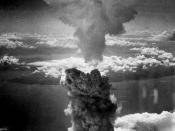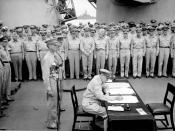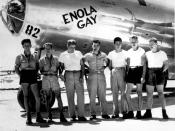Was it Necessary?
It is the morning of August 6, 1945. On the runway is the Enola Gay, a B-29 bomber, powering up her engines to leave for a mission that would change the world forever. Meanwhile, in Hiroshima, Japan, 2 B-29 bombers were sighted passing over the city by local military watchers. They are passed off as reconnaissance planes, and nothing more. The people continue about their daily lives.
It was about 8:11 a.m., when the Enola Gay approached her target. She climbed to about 31,000 feet and finished the settings on "Little Boy", the atomic bomb sitting in the bomb bay. The bomb was dropped on Hiroshima (Feis 121).
Much controversy has swelled in the decades that have followed the Atomic Bombing of Hiroshima and Nagasaki. Many people understand that the bombing of Hiroshima was seen as a possible necessity at the time to end the war.
But why was Nagasaki bombed? There are opinions that say Japan got the message after Hiroshima, that they were going to surrender. It has come out recently that this is far from true.
Some weeks before, there were meetings held at Potsdam, Germany. Truman and the heads of the United Nations had come up with a package that would allow the Japanese to surrender to the United Nations unconditionally, but would be able to return to their way of life without worry of outside policing by the nations involved in the war. It is believed that the Cold War between the United States and the USSR began here. Truman had a strategy of a "Delayed Showdown" in an effort to delay the Potsdam meeting until after the nuclear test. He was advised that the A-Bomb would intimidate the Russians for political leverage (Alperovitz 41-62). The basic essence of the Potsdam...



Grate job
very well written essay.
Also, this person well done in research.
This essay helped my reserch on the Effect of atomic bombing in Japan.
3 out of 3 people found this comment useful.